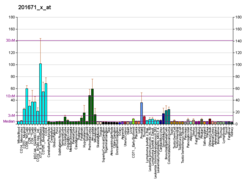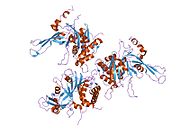Protein-coding gene in the species Homo sapiens
| USP14 |
|---|
 |
| Available structures |
|---|
| PDB | Ortholog search: PDBe RCSB |
|---|
| List of PDB id codes |
|---|
2AYN, 2AYO |
|
|
| Identifiers |
|---|
| Aliases | USP14, TGT, ubiquitin specific peptidase 14, Ubp6 |
|---|
| External IDs | OMIM: 607274; MGI: 1928898; HomoloGene: 3780; GeneCards: USP14; OMA:USP14 - orthologs |
|---|
| Gene location (Human) |
|---|
 | | Chr. | Chromosome 18 (human)[1] |
|---|
| | Band | 18p11.32 | Start | 158,383 bp[1] |
|---|
| End | 214,629 bp[1] |
|---|
|
| Gene location (Mouse) |
|---|
 | | Chr. | Chromosome 18 (mouse)[2] |
|---|
| | Band | 18 A1|18 4.91 cM | Start | 9,993,066 bp[2] |
|---|
| End | 10,045,119 bp[2] |
|---|
|
| RNA expression pattern |
|---|
| Bgee | | Human | Mouse (ortholog) |
|---|
| Top expressed in | - secondary oocyte
- tibialis anterior muscle
- deltoid muscle
- pons
- thoracic diaphragm
- trabecular bone
- trigeminal ganglion
- lateral nuclear group of thalamus
- skin of hip
- spinal ganglia
|
| | Top expressed in | - tail of embryo
- dorsomedial hypothalamic nucleus
- ventromedial nucleus
- dentate gyrus of hippocampal formation granule cell
- epiblast
- lateral septal nucleus
- mammillary body
- lateral hypothalamus
- superior frontal gyrus
- maxillary prominence
|
| | More reference expression data |
|
|---|
| BioGPS | 
 | | More reference expression data |
|
|---|
|
| Gene ontology |
|---|
| Molecular function | - cysteine-type peptidase activity
- proteasome binding
- peptidase activity
- protein binding
- thiol-dependent deubiquitinase
- cysteine-type endopeptidase activity
- endopeptidase inhibitor activity
- hydrolase activity
- tRNA guanylyltransferase activity
| | Cellular component | - membrane
- plasma membrane
- synapse
- cell surface
- proteasome complex
- extracellular exosome
- cytoplasm
- cytosol
- cytoplasmic vesicle
- nucleus
| | Biological process | - regulation of proteasomal protein catabolic process
- regulation of chemotaxis
- ubiquitin-dependent protein catabolic process
- proteolysis
- negative regulation of ER-associated ubiquitin-dependent protein catabolic process
- chemical synaptic transmission
- negative regulation of endopeptidase activity
- protein deubiquitination
- immune system process
- innate immune response
- tRNA 5'-end processing
| | Sources:Amigo / QuickGO |
|
| Orthologs |
|---|
| Species | Human | Mouse |
|---|
| Entrez | | |
|---|
| Ensembl | | |
|---|
| UniProt | | |
|---|
| RefSeq (mRNA) | | |
|---|
NM_001038589
NM_021522
NM_001360884 |
|
|---|
| RefSeq (protein) | | |
|---|
NP_001033678
NP_067497
NP_001347813 |
|
|---|
| Location (UCSC) | Chr 18: 0.16 – 0.21 Mb | Chr 18: 9.99 – 10.05 Mb |
|---|
| PubMed search | [3] | [4] |
|---|
|
| Wikidata |
| View/Edit Human | View/Edit Mouse |
|
Ubiquitin-specific protease 14 is an enzyme that in humans is encoded by the USP14 gene.[5][6]
This gene encodes a member of the ubiquitin-specific processing (UBP) family of proteases that is a deubiquitinating enzyme (DUB) with His and Cys domains. This protein is located in the cytoplasm and cleaves the ubiquitin moiety from ubiquitin-fused precursors and ubiquitinylated proteins. Mice with a mutation that results in reduced expression of the ortholog of this protein are retarded for growth, develop severe tremors by 2 to 3 weeks of age followed by hindlimb paralysis and death by 6 to 10 weeks of age. Alternate transcriptional splice variants, encoding different isoforms, have been characterized.[6]
Interactions
USP14 has been shown to interact with CXCR4.[7]
References
- ^ a b c GRCh38: Ensembl release 89: ENSG00000101557 – Ensembl, May 2017
- ^ a b c GRCm38: Ensembl release 89: ENSMUSG00000047879 – Ensembl, May 2017
- ^ "Human PubMed Reference:". National Center for Biotechnology Information, U.S. National Library of Medicine.
- ^ "Mouse PubMed Reference:". National Center for Biotechnology Information, U.S. National Library of Medicine.
- ^ Puente XS, Sánchez LM, Overall CM, López-Otín C (Jul 2003). "Human and mouse proteases: a comparative genomic approach". Nat Rev Genet. 4 (7): 544–58. doi:10.1038/nrg1111. PMID 12838346. S2CID 2856065.
- ^ a b "Entrez Gene: USP14 ubiquitin specific peptidase 14 (tRNA-guanine transglycosylase)".
- ^ Mines MA, Goodwin JS, Limbird LE, Cui FF, Fan GH (Feb 2009). "Deubiquitination of CXCR4 by USP14 is critical for both CXCL12-induced CXCR4 degradation and chemotaxis but not ERK activation". J. Biol. Chem. 284 (9): 5742–52. doi:10.1074/jbc.M808507200. PMC 2645827. PMID 19106094.
Further reading
- Wilson SM, Bhattacharyya B, Rachel RA, Coppola V, Tessarollo L, Householder DB, Fletcher CF, Miller RJ, Copeland NG, Jenkins NA (2002). "Synaptic defects in ataxia mice result from a mutation in Usp14, encoding a ubiquitin-specific protease". Nature Genetics. 32 (3): 420–425. doi:10.1038/ng1006. PMID 12368914. S2CID 23542012.
- D'Andrea A, Pellman D (1999). "Deubiquitinating enzymes: a new class of biological regulators". Crit. Rev. Biochem. Mol. Biol. 33 (5): 337–52. doi:10.1080/10409239891204251. PMID 9827704.
- Deshpande KL, Seubert PH, Tillman DM, Farkas WR, Katze JR (1996). "Cloning and characterization of cDNA encoding the rabbit tRNA-guanine transglycosylase 60-kilodalton subunit". Arch. Biochem. Biophys. 326 (1): 1–7. doi:10.1006/abbi.1996.0039. PMID 8579355.
- Reuter TY, Medhurst AL, Waisfisz Q, Zhi Y, Herterich S, Hoehn H, Gross HJ, Joenje H, Hoatlin ME, Mathew CG, Huber PA (2003). "Yeast two-hybrid screens imply involvement of Fanconi anemia proteins in transcription regulation, cell signaling, oxidative metabolism, and cellular transport". Exp. Cell Res. 289 (2): 211–21. doi:10.1016/S0014-4827(03)00261-1. PMID 14499622.
- Dennehey BK, Gutches DG, McConkey EH, Krauter KS (2004). "Inversion, duplication, and changes in gene context are associated with human chromosome 18 evolution". Genomics. 83 (3): 493–501. doi:10.1016/j.ygeno.2003.08.017. PMID 14962675.
- Hu M, Li P, Song L, Jeffrey PD, Chenova TA, Wilkinson KD, Cohen RE, Shi Y (2005). "Structure and mechanisms of the proteasome-associated deubiquitinating enzyme USP14". EMBO J. 24 (21): 3747–56. doi:10.1038/sj.emboj.7600832. PMC 1276716. PMID 16211010.
- Shinji S, Naito Z, Ishiwata S, Ishiwata T, Tanaka N, Furukawa K, Suzuki H, Seya T, Matsuda A, Katsuta M, Tajiri T (2006). "Ubiquitin-specific protease 14 expression in colorectal cancer is associated with liver and lymph node metastases". Oncol. Rep. 15 (3): 539–43. doi:10.3892/or.15.3.539. PMID 16465409.
- Crimmins S, Jin Y, Wheeler C, Huffman AK, Chapman C, Dobrunz LE, Levey A, Roth KA, Wilson JA, Wilson SM (2006). "Transgenic rescue of ataxia mice with neuronal-specific expression of ubiquitin-specific protease 14". J. Neurosci. 26 (44): 11423–31. doi:10.1523/JNEUROSCI.3600-06.2006. PMC 6674543. PMID 17079671.
External links
- Overview of all the structural information available in the PDB for UniProt: P54578 (Ubiquitin carboxyl-terminal hydrolase 14) at the PDBe-KB.
PDB gallery
-
1wgg: Solution Structure of the N-terminal Ubiquitin-like Domain of Mouse Ubiquitin Specific Protease 14 (USP14) -
2ayn: Structure of USP14, a proteasome-associated deubiquitinating enzyme -
2ayo: Structure of USP14 bound to ubquitin aldehyde |
 | This article on a gene on human chromosome 18 is a stub. You can help Wikipedia by expanding it. |

 1wgg: Solution Structure of the N-terminal Ubiquitin-like Domain of Mouse Ubiquitin Specific Protease 14 (USP14)
1wgg: Solution Structure of the N-terminal Ubiquitin-like Domain of Mouse Ubiquitin Specific Protease 14 (USP14) 2ayn: Structure of USP14, a proteasome-associated deubiquitinating enzyme
2ayn: Structure of USP14, a proteasome-associated deubiquitinating enzyme 2ayo: Structure of USP14 bound to ubquitin aldehyde
2ayo: Structure of USP14 bound to ubquitin aldehyde




















